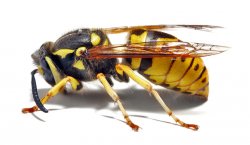Bees & Wasps
 As a rule, bees and wasps are beneficial insects and are unaware of the activities of man. At times, although, the nesting habits of these insects may be in close proximity to a home, or even in a home, as to cause problems. For some individuals, the consequences of a bee or wasp sting may be serious, resulting in a severe reaction or even death.
As a rule, bees and wasps are beneficial insects and are unaware of the activities of man. At times, although, the nesting habits of these insects may be in close proximity to a home, or even in a home, as to cause problems. For some individuals, the consequences of a bee or wasp sting may be serious, resulting in a severe reaction or even death.
Bees and wasps are either social or solitary insects. Social insects live in groups and colonies. Solitary insects do not live in groups. Solitary wasps (mud daubers, cicada killers, etc.) are not extremely aggressive and generally will not sting unless handled. Social wasps (yellow jackets, hornets, paper wasps) and social bees (honey bees) may readily sting to protect their nests and themselves.
Wasps can be distinguished from bees as follows: Bees appear to have hairy bodies whereas wasps appear to have smooth bodies. Wasps feed primarily on protein such as spiders and insects: bees feed on and give their young pollen, nectar and in some cases honey.
Wasps, because of their food preferences, exhibit scavenging behavior and are more of a nuisance to man. Wasps, mainly the social species, annoy us during outings and barbecues, competing with us for our food and soft drinks.
Yellow jackets, hornets and paper wasps construct nests made of paper. The nest of a paper wasp consists of one layer of open cells. They are often build in shaded, protected areas, like underneath eaves, in vents, behind window shutters and vents, attics and even trees and shrubs. The nests of the yellow jacket, bald-faced hornet and European hornet are composed of multiple layers of cells which are enclosed in a paper envelope. The cells cannot be observed from the outside. Yellow jacket nests may be found in the ground, inside a building or in a tree. Hornets nests are generally found in trees or shrubs but may be build on the outside of structures.
If you are stung by a bee or wasp and you encounter unusual swelling or irritation, or if these symptoms occur some distance away from the sting site, you should contact a physician immediately. Severe reactions from bee and wasp stings are rare but may include an increased heart rate; rapid, shallow, or labored breathing; or even shock. Such reactions are life-threatening and require immediate medical treatment. People allergic to bee and wasp venom can buy sting kits by prescription at most pharmacies.
Bumblebees
Bumble bees usually nest in cavities below ground, like rodent burrows, or they can be found above ground in trash piles, lumber piles, wall voids, etc. Nests are started in the spring by single fertilized females. Each bee builds a large irregular cell of wax and pollen and stocks it with pollen and nectar. Several eggs are laid in the cell; the female then enlarges it and supplies the young with additional food. She speeds the development of her eggs and young by incubating them. They become workers when mature and take over the tasks of pollen and nectar collecting, feeding young, and other nest duties. Honey and pollen may be stored in vacated cells. Nests rarely have more then a hundred workers at a time. Only future queens survive the winter by hibernating in the ground. Bumblebees are very important pollinators of many flowers. The sting of a bumblebee is very painful at the sting site, and is followed by local swelling and irritation. The intense pain doesn’t last long, and the swelling disappears after several hours. Itching and mild irritation may persist for a few days. If you are stung and your reaction includes unusual swelling
Honeybees
Honey bee colonies have 20,000 - 80,000 individuals. These colonies are raised for honey and beeswax, and are essential for pollination of crops. The honey bees’ stinger has barbs which allow the stinger and the poison sac to remain in the targets skin, etc. Unlike wasps, honey bees can only sting once.
Honeybees are also beneficial and in most instances should not be harmed. Sometimes, however, these bees can become a serious problem when they find an opening to enter and build their nests, such as in wall voids of structures, eves, chimney and attic void area, etc. The nest can survive year round if well protected. The nests are made of wax cells that may contain many pounds of honey. While alive, they have a built in cooling source. By fanning their wings they keep the wax from melting. If the bees and colony are killed this wax will begin to melt causing the honey to seep out. This may cause damage and will attract other insects. Removal of the nest and cleanup of the nesting cavity by a professional is highly advised when dealing with this type of problem.
Mud Dauber Wasps
Mud Dauber wasps are black wasps with a long thin waist and are not social wasps. They are not very aggressive wasps and very rarely sting people. Their nests, sometimes, are built in close proximity to people and their structures. This wasp constructs brood chambers from mud on the sites of buildings and homes. The wasp stings and paralyzes spiders, lays an egg on them, and seals them inside the chambers. The wasp larva hatches and feeds on the spiders. An emergence hole in the mud means that the wasp has emerged from the chamber.
Cicada Killer
The Cicada killer is a very large wasp measuring 1 9/16th inch in length. It has a black abdomen with pale yellow markings on the last three abdominal segments. Adults are seen in late July and August. This was gets its name from the fact that it uses cicadas as food for its young. Cicadas are large insects that are sometimes called “Locusts”. Cicada killers are solitary Wasps. Even though there may be many of these wasps flying over a lawn or hillside they do not nest together. Each female digs her own burrows. Burrows may be up to 10 inches deep and may extend another 6 inches horizontally. These burrows have piles of dirt piled up at their entrance. The full grown larvae hibernate in these burrows, pupate inn the spring and emerge the following summer as adults.
While cicada killers are beneficial in reducing cicada populations, they can cause lawn damage and are frightening to many people because of their large size and massive populations. Cicada killers can sting but fortunately only do so when strongly provoked.
Paper Wasps
Paper wasps are usually yellow with brown, black, yellow or red markings. These wasps are aggressive and readily sting. Paper wasp nests are made of a papery material that is shaped like an inverted umbrella. These nests usually have a single comb with as many as 250 or so wasps within the nests. Nests are often built under eaves, behind window shutters or on branches of shrubs. Homes and buildings with shake type siding and roofing shingles also attract these wasps and their nest building practices. The eggs are laid in a cell; the larvae hatch and are fed by the wasps. These wasps generally forage for caterpillars and other small insects to feed the larvae.
Yellow Jackets
Yellow jackets are generally small wasps with black and yellow stripes and about ¾ to 1 inch in length. These wasps are social insects that live in colonies containing thousands of individuals. Colonies are usually started by a single queen in the early spring, and are very small for the first couple of months. By midsummer, a colony located on or near a house is usually large enough to become a nuisance or even a health threat. These wasps will aggressively attack when their nest is disturbed, and can inflict painful stings. Unlike the honeybee, which stings only one time and then dies, a single yellow jacket can sting many times. Yellow jackets are scavengers and can be beneficial when located in a wooded are or in a field. Colonies located in or near the home, however, can pose a threat to the persons living in the house. When this situation is discovered, the colony or colonies should be eliminated. Because of the danger involved in treating these nests, as well as hornet nests, only a professional such as Gotcha! Pest Control Specialists should attempt to treat them. Should a colony be discovered, contact your Gotcha! Pest Control Specialist for assistance.
Yellow jackets prefer to locate their nests in the ground, usually in an old rodent burrow or similar hole. This Wasp also commonly locates its nest inside the walls of a building by entering through cracks or holes in the outside walls.
Tips for control include: The following precautions should be taken to prevent accidental stings: When working in a garden or flowerbed, be aware of the numerous wasps flying into and away from a single point in the garden or to a hole in the side of the house. This will usually indicate where a colony might be located. Be careful when using powered lawn equipment, such as edgers, trimmers and mowers. Loud, vibrating noises disturb yellow jackets and may send them into an attacking frenzy. Stay away from yellow jacket nests once you know where they are located. If yellow jackets are seen entering and exiting a wall, DO NOT seal or plug the hole. You will force the wasps to find another way out. Sometimes they might actually eat through an interior wall or ceiling and enter the house.
